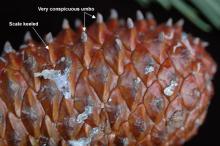Pinus pinaster
Common name:
Maritime Pine
Cluster Pine
Turpentine Pine
Pronunciation:
PI-nus pin-AS-ter
Family:
Pinaceae
Genus:
Type:
Conifer
Native to (or naturalized in) Oregon:
No
- Conifer, evergreen, 65-100 ft (20-30 m) tall, fast growing, conical crown, older trees often without branches on the lower 3/4 of the trunk. Bark thick, red-brown, deeply split. Needles arranged 2 per cluster, 10-20 cm long, straight or gently curved, stiff, glossy, prickly tip, margin finely toothed, many stomatal lines on both surfaces, needle sheaths blackish, 20-25 mm long; needles clustered at ends of branches. Cones broadly oval-conical, asymmetrical, 9-18 cm long, 5-8 cm wide, often in clusters of 2-4(7), purple when young, light brown and glossy when mature, scale ends rhombic, about 15 mm wide, sharply keeled, umbo (protuberance on the end of the cone scale, i.e., "prickle") is very conspicuous.
- Sun. Does well near ocean costs
- Hardy to USDA Zone 7 Native to the Mediterranean region from the Atlantic to Greece; widely cultivated and several selections available.
- pinaster: Latin for wild pine, the ending -aster indicating "one inferior to the cultivated pine (Pinus pinea)" [Italian Stone Pine], (Stearn, 1996).
- Oregon State Univ., Peavy Arboretum.










